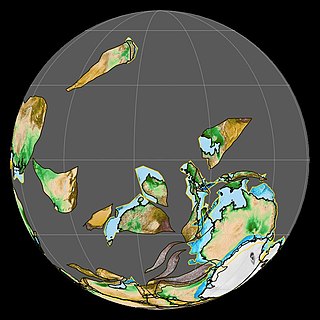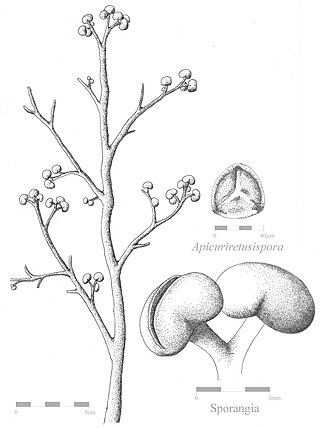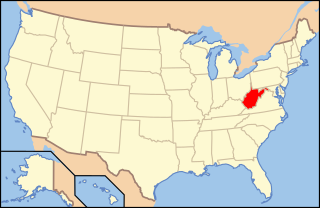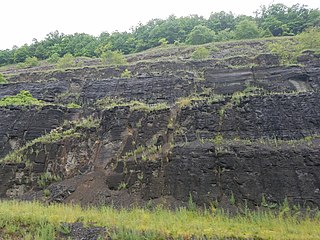
The Carboniferous is a geologic period and system of the Paleozoic that spans 60 million years from the end of the Devonian Period 358.9 Ma to the beginning of the Permian Period, 298.9 Ma. In North America, the Carboniferous is often treated as two separate geological periods, the earlier Mississippian and the later Pennsylvanian.

The Tournaisian is in the ICS geologic timescale the lowest stage or oldest age of the Mississippian, the oldest subsystem of the Carboniferous. The Tournaisian age lasted from 358.9 Ma to 346.7 Ma. It is preceded by the Famennian and is followed by the Viséan. In global stratigraphy, the Tournaisian contains two substages: the Hastarian and Ivorian. These two substages were originally designated as European regional stages.

The Bear Gulch Limestone is a limestone-rich geological lens in central Montana, renowned for the quality of its late Mississippian-aged fossils. It is exposed over a number of outcrops northeast of the Big Snowy Mountains, and is often considered a component of the more widespread Heath Formation. The Bear Gulch Limestone reconstructs a diverse, though isolated, marine ecosystem which developed near the end of the Serpukhovian age. It is a lagerstätte, a particular type of rock unit with exceptional fossil preservation of both articulated skeletons and soft tissues. Bear Gulch fossils include a variety of fish, invertebrates, and algae occupying a number of different habitats within a preserved shallow bay.

Megarachne is a genus of eurypterid, an extinct group of aquatic arthropods. Fossils of Megarachne have been discovered in deposits of Late Carboniferous age, from the Gzhelian stage, in the Bajo de Véliz Formation of San Luis, Argentina. The fossils of the single and type species M. servinei have been recovered from deposits that had once been a freshwater environment. The generic name, composed of the Ancient Greek μέγας (megas) meaning "great" and Ancient Greek ἀράχνη (arachne) meaning "spider", translates to "great spider", because the fossil was misidentified as a large prehistoric spider.

Falcatus is an extinct genus of falcatid chondrichthyan which lived during the early Carboniferous Period in Bear Gulch bay in what is now Montana.

Renalia is a genus of extinct vascular plants from the Early Devonian. It was first described in 1976 from compressed fossils in the Battery Point Formation. It is difficult to reconstruct the original form of the complete plant, but it appears to have consisted of leafless branching stems whose side branches had sporangia at their tips. It is regarded as an early relative of the lycophytes.
Hedeia is a genus of early land plants of uncertain affinity. It comprises erect axes terminating in corymbose clusters of erect sporangia.

Paleontology in West Virginia refers to paleontological research occurring within or conducted by people from the U.S. state of West Virginia. West Virginia's fossil record begins in the Cambrian. From that time through the rest of the early Paleozoic, the state was at least partially submerged under a shallow sea. The Paleozoic seas of West Virginia were home to creatures like corals, eurypterids, graptolites, nautiloids, and trilobites at varying times. During the Carboniferous period, the sea was replaced by lushly vegetated coastal swamps. West Virginia is an excellent source of fossil plants due to these deposits. These swamps were home to amphibians. A gap in the local rock record spans from the Permian to the end of the Cenozoic. West Virginia was never the site of glacial activity during the Ice Age, but the state was home to creatures like mammoths, mastodons, and giant ground sloths. One local ground sloth, Megalonyx jeffersonii, was subject to the scholarly investigations of Thomas Jefferson, who misinterpreted the large-clawed remains as belonging to a lion-like predator. In 2008, this species was designated the West Virginia state fossil.

The Bluestone Formation is a geologic formation in West Virginia. It is the youngest unit of the Upper Mississippian-age Mauch Chunk Group. A pronounced unconformity separates the upper boundary of the Bluestone Formation from sandstones of the overlying Pennsylvanian-age Pocahontas Formation.

The Bluefield Formation is a geologic formation in West Virginia. It preserves fossils dating back to the Mississippian subperiod of the Carboniferous period. Sediments of this age formed along a large marine basin lying in the region of what is now the Appalachian Plateau. The Bluefield Formation is the lowest section of the primarily siliciclastic Mauch Chunk Group, underlying the Stony Gap Sandstone Member of the Hinton Formation and overlying the limestone-rich Greenbrier Group.
The Cumnock Formation is a Late Triassic-age geologic formation in North Carolina. It is found in the Sanford sub-basin of the Deep River Basin, the southernmost of the large Mesozoic basins forming the Newark Supergroup. It is the middle unit of the Chatham Group, overlying the Pekin Formation and underlying the Sanford Formation. Both of these encompassing formations are primarily red sandstone. The Cumnock Formation, on the other hand, represents a sequence of darker lacustrine (lake) or paludal (swampy/marshy) sediments deposited in a tropical climate. These primarily include shales and coal, with some thin layers of coarser sediment such as siltstone and sandstone.
The Helms Formation is a geologic formation in Texas and New Mexico. It preserves fossils dating back to the Chesterian (Serpukhovian) Age of the Carboniferous period.

The Battery Point Formation is a geologic formation in Quebec. It preserves fossils dating back to the early Emsian to early Eifelian the lower Devonian period.
The Campbellton Formation is a geologic formation in New Brunswick. It preserves fossils dating back to the latest Pragian and Emsian of the Devonian period.
Patricia Gabbey Gensel is an American botanist and paleobotanist.

Adelophthalmidae is a family of eurypterids, an extinct group of aquatic arthropods. Adelophthalmidae is the only family classified as part of the superfamily Adelophthalmoidea, which in turn is classified within the infraorder Diploperculata in the suborder Eurypterina.

This timeline of eurypterid research is a chronologically ordered list of important fossil discoveries, controversies of interpretation, and taxonomic revisions of eurypterids, a group of extinct aquatic arthropods closely related to modern arachnids and horseshoe crabs that lived during the Paleozoic Era.
Retispora lepidophyta is a spore type and an important biostratigraphic marker of the latest Devonian period. The last appearance of Retispora lepidophyta defines the Devonian-Mississippian boundary in Belgium and other places.
Beecheria is an extinct genus of brachiopod belonging to the order Terebratulida and family Beecheriidae. Fossils of this genus have been found in Mississippian to Permian beds in Eurasia, Australia, North America, and South America. The genus was part of the Levipustula fauna characteristic of cold water conditions. "Nests" of Beecheria have been found in fossil low temperature hydrothermal vent communities from the early Carboniferous in Newfoundland.
Diaphragmus is an extinct genus of brachiopod belonging to the order Productida and family Linoproductidae. Specimens have been found in Carboniferous beds in North America.












